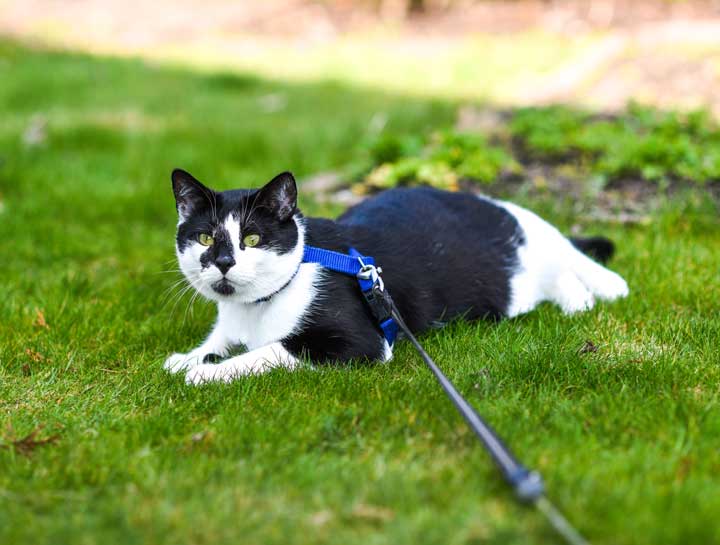Walking Your Cat on a Leash–the Whys and Hows

There’s no doubt that the majority of cats love watching the outside world through the windows of their homes. Some kitties are even free to come inside and out as they please. If you’re worried your cat may go outside and not come back, or if you just want the companionship of your feline friend on a walk, then training your cat to walk on a leash may be a good solution. Not every cat will enjoy—or even tolerate—walking on a leash. Even dogs require some training to become accustomed to being led by a leash. This is even more true for cats.
So just what type of leash system should you look for? How do you pick the right one for your cat? How do you put it on? After all that, how do you get the cat to go on a walk? Is it safe?
Types of leashes – which one is right for you?
First and foremost, never walk your cat with a leash attached to a collar. Even if your kitty is used to wearing a collar, the collar can choke or slip over their head when tethered to a leash. Dog harnesses are also an inappropriate choice; although they may look similar, harnesses specifically made for cats are more secure—not to mention more comfortable!
When shopping for a cat harness, you’ll find a few different types. The first type on our list is the H-style harness. H-style harnesses typically have a section that clips around the cat’s neck and another section that fits around the chest with a connecting piece in the middle, forming what looks like the letter H. Some cats prefer these harnesses because they have fewer contact points than others. That, however, can make it easier for your cat to wiggle free.
Closely related to the H-style harness is the figure 8. Also boasting little contact area, figure 8 harnesses are harder to escape, and some are even advertised as guaranteed escape-proof. However, if your cat likes to pull or is frightened by something and takes off, the straps of this harness can dig in, potentially making a scary situation worse.
Vest harnesses are very popular, as they can be more secure, but they have the most surface contact with your kitty, which can be intolerable for some but comforting to others. They apply gentle pressure the same way a soothing thunder shirt would. Some vests have to be pulled over the head, while others have a step-in feature that fastens on the back.
Other harnesses are variations of these themes. The choice comes down to which is the most secure for your cat—and their escape artist and comfort levels—both in material and style.
Vest harnesses may be too hot for some climates, such as a Florida summer. But they may be perfect for a Vermont fall. Some materials are more breathable than others, while some offer the extra insulation you may be looking for.
How do I put a harness on my cat?
Proper fit is of crucial importance, both for security and comfort. Each harness will likely have a specific area on your cat for you to measure, so be sure to refer to the sizing guide specifically for whichever harness you purchase. Many local pet stores have excellent return policies, so if your kitty can’t accompany you to the store for a fitting session, the store may allow you to return or exchange it. Check their return policy before purchasing just to be sure.
The harness should also come with directions on fastening it properly around your cat. Take care not to catch fur into the clips or velcro, especially on longer hair cats.
Make putting the harness on a positive experience. Let your cat explore the harness first. Introduce putting it on when your kitty is in a relaxed mood.
Let them hear all the sounds it will make – clips clicking or velcro ripping. Offer a favorite treat while putting it on and again after it’s on. If your cat is fighting or getting stressed, don’t force them. Take a break and try again, maybe the next day.
After your kitty is in their harness, let them get adjusted to it in small increments, just wearing it around the house. Soon (hopefully), they’ll forget it’s even on!
So how do you train a cat?
Now for the fun part! (There may or may not be sarcasm in that statement.) It will be much easier to start the training indoors, in a familiar environment. Attach the leash to the harness and let your cat go where it wants to, with you following behind. Do not try to pull your cat in the direction you want it to go.
When your cat feels comfortable with this, you may progress by giving the leash a gentle tug to encourage your kitty to either leave something alone or get them to move in the direction you wish to go. Use treats or feather toys to direct them. Remember, this is not a dog who may be happy to follow your lead. You may need to help kitty think this is all their idea!
Now, it’s time to go outside. Be sure to carry your kitty out the door to ensure they don’t think it’s okay to escape the house they please. Start with just letting your cat stand in your yard or the area around where you live.
Let them get used to the sights, sounds, and smells. Walk where your cat wants to go. If they seem stressed, keep the outdoor sessions brief at first. It may take days—or even weeks—for some cats, but soon your kitty will be exploring the neighborhood with you!
Is it dangerous to have a cat on a leash?
While there are proponents and opponents to cat walking, ultimately, the choice is up to you. After all, there is no law against it. (Although if you live in Sterling, Colorado, we hear you need to attach a tail light to your cat if they are going to be out at night!) If you ensure a well-fitting harness and take the time to train your cat, then walking on a leash can be entertaining, stimulating, and a great source of exercise for your cat.
Just be sure never to leave your cat unattended while wearing the harness. Stay alert to approaching dogs and try to avoid dog walkers. Be sure your cat is on parasite prevention, so they don’t bring home uninvited guests like fleas or ticks. Any cat, indoors or out, should be on a heartworm preventative, as well as flea and tick protection. Let your cat set the pace, and have fun! If you have more questions about walking your cat on a leash, Northeast Animal Hospital and its team of veterinarians would be more than happy to answer any questions you have! Contact us by calling 727-822-8501.
